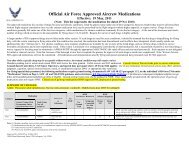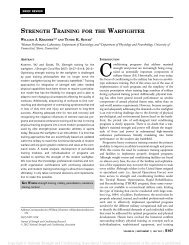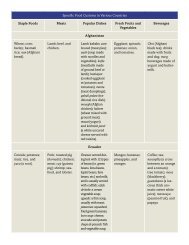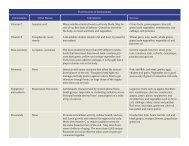Force Health Protection: Nutrition and Exercise Resource Manual
Force Health Protection: Nutrition and Exercise Resource Manual
Force Health Protection: Nutrition and Exercise Resource Manual
Create successful ePaper yourself
Turn your PDF publications into a flip-book with our unique Google optimized e-Paper software.
Use Worksheet B-2 as a template to design your workout <strong>and</strong> to record<br />
your training progress. Change the exercises you perform for each muscle<br />
group every four to eight weeks, even if you keep the same set <strong>and</strong> rep<br />
routine. Changing exercises will overload the muscles differently, increase<br />
your strength gains, <strong>and</strong> alleviate boredom. To increase their upper body<br />
strength, women should perform exercises that target the back, neck, chest,<br />
shoulders <strong>and</strong> arms (Figure 7-2).<br />
Equipment<br />
Strength training requires minimal personal gear: weights, a pair of<br />
supportive shoes, fitted lifting gloves, <strong>and</strong> st<strong>and</strong>ard PT attire. A weight<br />
lifting belt is only recommended during maximal or near maximal lifts, <strong>and</strong><br />
is not recommended at all for exercises that do not stress the back. This is<br />
because the belt takes over the role of the abdominal muscles in stabilizing<br />
the torso, preventing the strengthening of the abdominal muscles which can<br />
increase the risk for injury when lifting a heavy object without the belt.<br />
The most common barbells found in gyms are Olympic style barbells.<br />
These barbells have a narrow center bar for gripping <strong>and</strong> wider ends for<br />
loading weights. They are 5 to 7 ft. long <strong>and</strong> weigh 30 to 45 pounds (lbs) or<br />
13 to 20 kilograms (kg). The plates used to load the bars are available in<br />
both lbs <strong>and</strong> kg, <strong>and</strong> range between 2.5 to 45 lbs or 1.25 to 20 kg. Make sure<br />
you pay attention to the weight measurements in your gym; there is a big<br />
difference between 10 lbs <strong>and</strong> 10 kg! Lastly, you are encouraged to use<br />
adjustable collars to keep the plates on the bar. Depending on the style of<br />
collar, the pair can add 1 to 5 lbs to your bar. There are several other styles<br />
of barbells which range in size <strong>and</strong> weight. Ask a staff member at your gym<br />
to help you determine which barbell would best suit your needs.<br />
Choosing free weights, machines, or a combination of both depends largely<br />
on your goals <strong>and</strong> training experience. Table 7-2 lists a comparison of free<br />
weights <strong>and</strong> machines to help you with your choice. If you are new to a<br />
fitness center or if you are unsure how to work a piece of equipment, ask a<br />
fitness center staffer for an orientation. This orientation will help you design<br />
a workout routine based on the equipment selection at your fitness center.<br />
<strong>Nutrition</strong> <strong>and</strong> <strong>Exercise</strong> <strong>Resource</strong> <strong>Manual</strong> 63






![Body Composition and Military [PDF] - Human Performance ...](https://img.yumpu.com/43269347/1/190x245/body-composition-and-military-pdf-human-performance-.jpg?quality=85)
![Tips for Grocery Shopping [PDF]](https://img.yumpu.com/37447379/1/190x245/tips-for-grocery-shopping-pdf.jpg?quality=85)



![Synthetic Drugs [PDF] - Human Performance Resource Center](https://img.yumpu.com/37447322/1/190x245/synthetic-drugs-pdf-human-performance-resource-center.jpg?quality=85)


